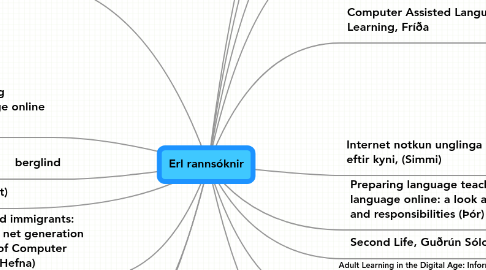Erl rannsóknir
作者:Solveig Jakobsdottir


1. Computer Assisted Language Learning (Björk)
1.1. Tungumálakennsla í samb. við tölvur.How can the use of blog software facilitate the writing process of English language learners?
2. Design (Kiddý)
2.1. Technology & Children:EDITORIAL green technology: redesign.
3. Feedback (Jóhanna Beck)
3.1. The sound of feecback in higher education. Learning, media and technology.
4. teaching language online (Sigga)
4.1. Preparing language teachers to teach language online: A look at skills, roles and responsibilities. (Computer assisted language learning Vol 22 nr1 February 2009 bls73-99)
5. Þátttaka, virkni (Ágúst)
5.1. Þátttaka á félagsvefjum
6. Beyond natives and immigrants: exploring types of net generation students. Journal of Computer Assisted Learning(Hefna)
7. berglind
7.1. A Research Agenda for Online Teacher Professional Development.
8. Multitask (Hilmar)
8.1. Can students really multitask? An experimental study of instant messaging while reading (Computers & Education, Vol 54, issue 4)
9. Nína
9.1. Technlogy and children
10. Mathematics(jón)
10.1. Computers and Mathematical Philosophies in Educational Trends
10.1.1. The Journal of Computers in Mathematics and Science Teaching
11. Representational competence (Hanna)
11.1. Supporting Representational Competence in High School Biology With Computer-Based Biomolecular Visualizations (The Journal of Computers in Mathematics and Science Teaching; 2007, Vol. 26, Iss. 1)
12. Distance education (Guðrún Þóra)
12.1. Learner and instructor identified success factors in distance education (Distance Education Nov 2008; Vol.29, Iss.3)
13. Internet notkun unglinga eftir kyni, (Simmi)
13.1. Junior high school students’ Internet usage and self-efficacy: A re-examination of the gender gap. (Computers & Education, Vol 54, issue 4)
14. Second Life, Guðrún Sólonsd
14.1. Tutoring at a distance, online tutoring and tutoring in Second Life David Hawkridge, Matthew Wheeler
14.1.1. http://www.eurodl.org/
